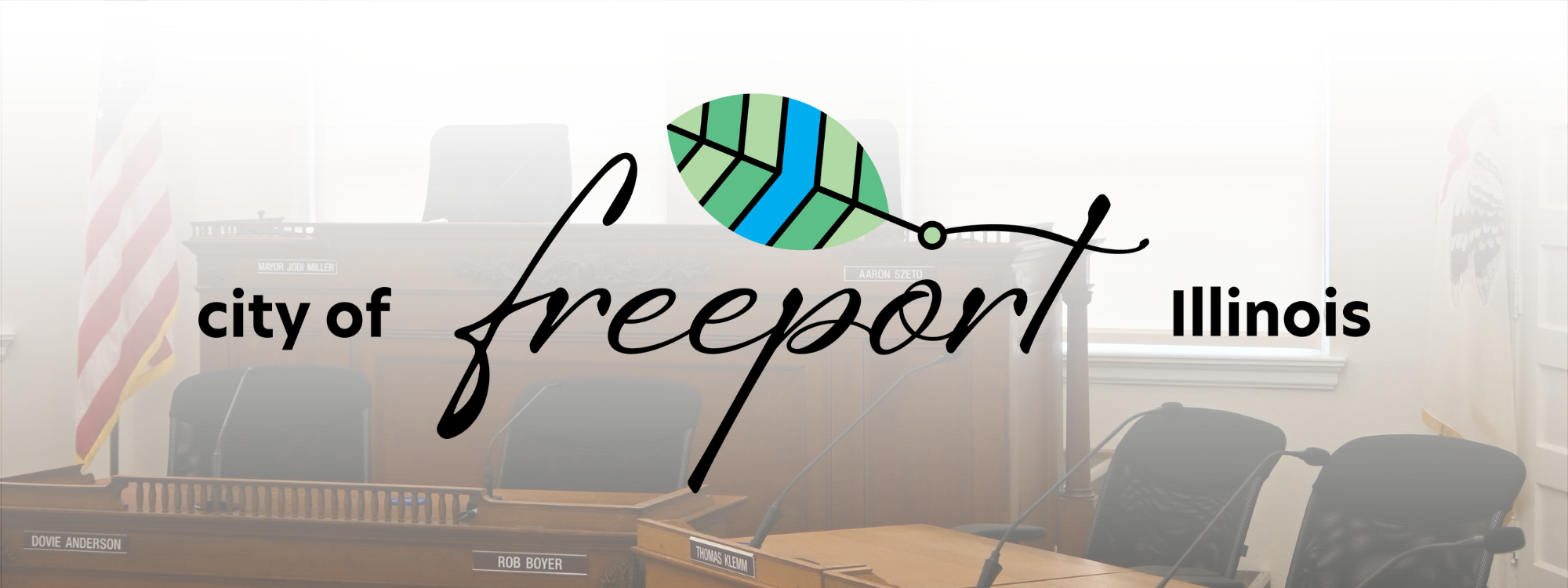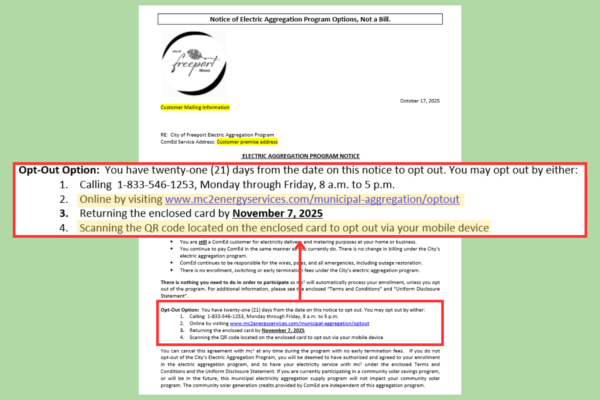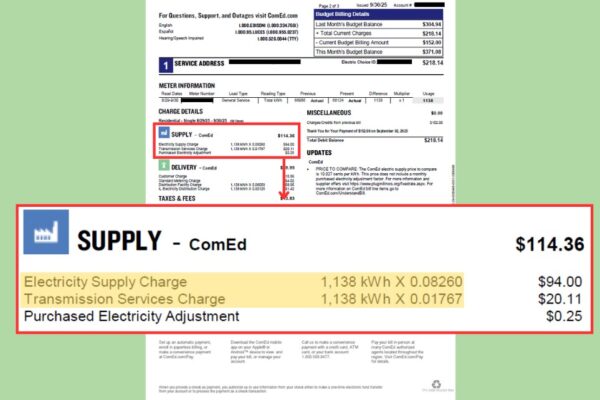Electrical Aggregation Program, Information on Letters and More

FREEPORT, IL – WATCH THIS PRESENTATION: (15:37-28:46)
The following was written to aid residents in making a decision on their electric supplier:
Around 2010, the Illinois Power Agency Act, otherwise known as the IPA Act, was amended to include Chapter 20, Section 1-92, which essentially reads as the following:
“Municipalities, townships, or county boards can adopt ordinances to aggregate residential and small commercial electrical loads within their jurisdictions. This allows them to solicit bids and create service agreements for buying electricity and related services. A majority vote from each participating municipality or township is necessary to authorize this aggregation, especially if it is to be an opt-out program for customers. Before an ordinance can be adopted for this purpose, a referendum must be conducted to gauge the residents’ support for such a program. The proposed question in the referendum will ask residents if they wish to allow local authorities to arrange electricity supply for customers who do not opt out.”
So in March of 2012, a referendum was put on the ballet whether the residents of Freeport wanted to participate in this program. The majority voted yes. The City then held two public hearings in May 2012 before bringing it to this council, where all eight alderpersons approved the implementation of the program.
Since that time, the City of Freeport has entered into agreements with many different providers who supply energy at a fixed rate compared to ComEd’s fluctuating rates. Trends show that at the time of these letters going out that we are about to discuss, the fixed rate is often just a bit higher than ComEd’s rate. However, over the course of their agreement with the City, the fixed rate becomes a more viable option for those not wanting to be affected by a fluctuating market.
A large part of the program is sending letters to residents, notifying them that they will be receiving a different supply rate unless they opt-out. One of my main goals is to be as clear as possible on what residents should do with this letter. Just last year, City Hall received hundreds of phone calls from residents with questions. So here we go.
Each and every household will receive a letter from MC2 beginning October 17. This letter has the City logo at the top. There are four different variations that residents could receive. However, I will be focusing on the most popular version residents will receive, that being the one that asks residents if they’d like to Opt-Out. If residents do nothing with this letter, they WILL be enrolled in the program.
So let’s discuss how residents are able to opt-out. The letter outlines 4 different ways to Opt-Out. I would highly recommend using technology to accomplish this. There will be a QR code in each envelope that residents can scan and fill in information without having to talk to anybody and be opted out in a matter of seconds. On each letter the actual link is given as well to go to the same page which can, again, be completed in a matter of seconds.
If those two options aren’t your style, there are two other options. Residents can call the toll-free number on the letter and quickly speak to a real human about their decision. This option may take a little bit longer due to wait times and other factors. And finally, the option I would suggest the least unless you have limitations would be to mail back a signed card that will be included in each envelope. There were many residents last year who took this route to opt-out and had struggles which then led to frustration and anger.
I’ll stress this again before I move on to why this program can be a benefit, “If you do not opt-out of the City’s Electric Aggregation Program, you will be deemed to have authorized and agreed to your enrollment in the electric aggregation program.”
So why do some residents participate in this program? I’d like to show you a sample energy bill. You can see that Delivery is still controlled by ComEd. But what this program does is offer a different rate for the highlighted section titled “Supply”. If that section says ComEd, that would mean you have a fluctuating rate, one that we have observed spike and even plateau at times. However, if that section shows the name of the current program participants, this time it would read MC Squared Energy, that would mean that your rate is fixed for the duration of the agreement.
I’d like to quickly show you what some of these numbers mean. With supplier energy charges highlighted, we see how many kilowatts per hour this resident used during the month. That number is then multiplied by the rate that I keep referring to in this presentation. You can see that this rate is 10.027 cents per KWH (ComEd adds splits its rate up into two line items, the example below shows ComEd’s rate as 8.26 cents plus 1.767 cents). If this resident was enrolled in the upcoming electrical aggregation program, that rate would be 9.89 cents per KWH. Everything else on your bill is not affected by this program.
It’s also important to understand the distinction between ComEd and MC2. In a power outage or other emergency, who does one call? Let’s look at this graphic from the Citizen’s Utility Board, where we can better understand that the power lines that deliver the actual energy to our homes are still owned by ComEd, regardless of our participation in this program. The main difference is in the electricity supply and cost. The same section that we just looked at on a sample energy bill.
I’ll quickly address a main concern that we heard often from residents calling City Hall last year. The legality of this program. I’ve already outlined how Freeport adopted this program, through a referendum that was voted on by residents themselves, and of course the council approving the implementation of it. But I’d like to use what the Citizen’s Utility Board has to say about the legality of this matter to address resident concerns.
This is straight from the Citizen’s Utility Board: “[The Illinois Power Agency Act] allows municipalities and counties to purchase electricity on behalf of residential and small-business utility customers living within their borders.” Plugin.illinois.gov has a full list of those participating in this program. Hundreds of communities across the state have implemented this program for their residents.
To residents who may still question the legality of the manner in which they must opt-out, I highly suggest reviewing the Illinois Power Agency Act, specifically Chapter 20, Section 1-92.
The most important thing I want to stress is, please stay on the lookout for a letter in your mailbox in the coming weeks. Do not throw mail away that you have not checked. And of course, if residents have any questions, they can certainly call me at (815) 801-8008 and we can see if we can resolve those concerns.
WATCH THIS PRESENTATION: (15:37-28:46)
Disclaimer: Links on this page may take you to pages outside of the City’s website. Please note that these pages may contain functions that allow you to “Send Feedback” or to post comments/questions. Please note that these functions may be directed to third party sites and not to the City of Freeport. If you have any feedback intended for the City of Freeport, please contact the City directly.

